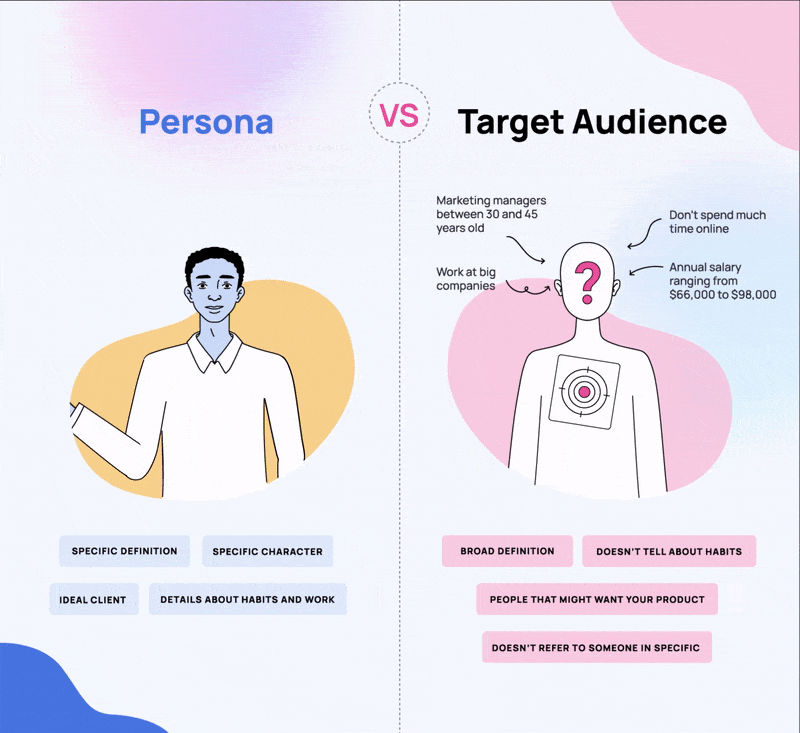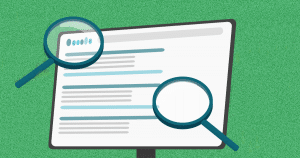When developing any kind of strategy, you must know precisely the people you are targeting.
Working with buyer persona examples is the best way to go about it. With this valuable resource, you are able to visualize exactly who your audience is and how to satisfy their specific needs.
Your strategic efforts may differ vastly, depending on the audience you are trying to reach. Using a buyer persona model will help you adapt your approach to the correct people and increase your success.
You must also consider the various differences between markets and how that has an impact on the reached audience.
B2C and B2B businesses tend to have radically different marketing and sales initiatives and that also applies to the buyer persona.
With that in mind, you must create the appropriate buyer personas for your business strategies. By doing that, you will be able to enjoy several advantages and improvements to your results.
Here is everything you will see in this article:
Download this post by entering your email below
What is a Buyer Persona?
A buyer persona is a semi-fictional character that represents a slice of your target audience.
It’s somebody with all the traits of a real client of your business, with all the relevant information for your strategy.
So, instead of focusing on “men and women, ages between 25 and 30, middle class”, we would target Bradley, who is a 27-year-old aspiring marketer in a medium-sized firm. You can further discuss Bradley’s traits, such as his need for a way to fit more studies into his schedule and desire to become head of marketing.
Check out this animated infographic to understand better the difference between customer persona and target audience:

Working with a buyer persona is different from using traditional target audiences.
After all, it’s a more specific look into a portion of this public. In addition, it has valuable data about their motivations, needs, desires and others, which help you come up with the right approaches.
Depending on your business’ field, you might need to add specific pieces of information to your customer persona.
It’s also important to differentiate B2B buyer personas from B2C. You’ll learn more about it further below.
Why is it Important to Work with Buyer Personas?
Developing buyer personas for your strategy is critical for your results.
This is the best way to make sure every element in your campaigns work. It’s things like tone of voice, visual elements, type of content, best media channels, and others.
Such usefulness is due to how specific the information is on a buyer persona.
By knowing exactly what their motivations and needs are, you can create the best marketing and sales approach to convince them about your product. If you choose a vaguer target audience, this job becomes harder.
Working with buyer personas also helps you deepen your knowledge about your product’s value.
After all, you are able to see the positive effect it has on the people you try to reach. By seeing how these people interact with your business, you might acquire valuable insights about your services.
Lastly, having buyer personas is a great way to empathize with your target audience. By understanding their fears and needs, you are able to strengthen your relationship with them.
7 Types of Personas
In many cases, when developing buyer personas, you want to focus on core features like age, marital status, income level, and gender. However, you can also categorize different personas into broader classifications. Here are seven different classes you can use to determine which type of persona you want to build, and then narrow down your search from there.
1. User Persona
A user persona reflects all the potential users of a specific product or service. So, you want to be relatively broad without being vague, but also focused without being too niche.
This persona type helps you understand who uses your product, even if you have multiple versions or tiers. For example, let’s say you have a freemium version of your software and a paid version. A user persona focuses on anyone who would be interested in the program, not just those who are willing to pay for it.
The benefit of using this persona type is that you can understand who wants your product and then figure out ways to nudge them into becoming paid customers.
2. Buyer Persona
Technically, we’re discussing all kinds of buyer personas, but this classification focuses on a holistic approach to marketing to a specific user or demographic. A buyer persona is someone who makes the final decision, but they have more to consider than just whether the product will fill a specific need right now.
Buyer personas are helpful for B2B companies because they encompass the decision-makers, not just those at the lower levels. So, developing this persona allows you to focus your energy on getting managers and executives to say yes to your product so you can close the deal.
3. Customer Persona
If you’re already running a business, you can develop a persona based on the people who are buying from you already. While there will always be some outliers, you can likely create a pretty compelling persona based on information you already have.
The primary purpose of developing this persona is to understand who likes your product currently and sell to more people that fit the profile. The second purpose is to help your existing customers get more value by expanding their purchases with your company. After all, if they’re already on board with what you’re selling, they’re more likely to take a chance on something else you have to offer.
4. Proto Persona
This category is helpful if you haven’t launched your business yet but know who you want to buy your products. A proto-persona is an “ideal” customer, but you still want it to be realistic. For example, if you aim too high in the persona’s income level or pain points, it’ll be much harder to appeal to real people who may be interested in what you have to offer.
Another point to remember about proto-personas (and all buyer personas) is that you don’t want to get too into the weeds with their background. Yes, it helps to know a bit more about someone’s life and why they want what you’re selling, but knowing too much “trivia” won’t help you close sales.
5. Audience Persona
Usually, a buyer persona is reflective of a single person who might represent a niche demographic. An audience persona takes a step back and groups people based on broader interests and pain points.
To develop an audience persona, you use market research and data to compile into a general idea of the type of person who may want your product. So, you’ll have an age range, a set of interests, and generic pain points, but nothing too specific. Audience personas are great for branching out into new markets, but you’ll need to narrow your focus as you move forward with your marketing campaign.
6. Marketing Persona
As with an audience persona, a marketing persona is broad and somewhat vague. The idea behind developing this persona is if you’re not sure who specifically will be interested in your product, so you need to cover a wider range of individuals until you can narrow them down.
Marketing personas are usually based on a handful of data points, like age, income level, and job description. From there, you can develop individual personas to ensure you can target niche groups within the larger demographic.
7. Student Persona
This persona only works if you want to educate individuals, such as if you run a cosmetics or bartending school. In this case, you have to understand why that individual is enrolling in your course and what they hope to get out of it. You must also address unique pain points such as having a full-time job, having a limited income or budget, and their availability. For example, what if your ideal student has children and can’t get childcare during the week?
The Difference Between B2B and B2C Buyer Persona Examples
Marketing as a B2B company is much different than a B2C enterprise. So, you need to develop unique buyer personas for each situation so you can adapt to their individual and specific needs. Here’s a quick breakdown of the various ways that B2B and B2C personas differ from each other.
- Short vs. Long-Term – A customer may purchase a product or service for an immediate need or for something that they plan to do in the near future. For example, a person may buy cleaning products to help them clean their kitchen or bathroom. A B2B client, however, is mostly focused on long-term goals. Typically, the product or service will be ongoing and address specific problems with a company’s daily operations, not a one-time issue.
- Individual vs. Company-Based – A single customer is the sole decision-maker when agreeing to a purchase. So, your sales team only has to appeal to their interests and needs to close the deal. With a B2B enterprise, though, many people can be involved in the decision, and individual needs rarely come into play. For example, just because one person likes the product doesn’t mean everyone will approve of buying it. If it doesn’t improve the bottom line, it’s hard to justify its purchase.
- Rationality vs. Emotion – There’s a strong misconception that B2B clients never use their emotions when making a purchase decision. While this isn’t entirely true, the myth likely stems from the fact that these clients can’t make decisions on impulse. So, while emotions can come into play, the client can’t pull the trigger immediately. Because the B2B sales process is lengthier, these emotions and pain points must be sustained, so it seems more rational once the deal is closed. Individual customers, though, can make impulse purchases based on how they’re feeling right now, so salespeople can appeal to their emotional state more easily.
Overall, B2B buyer personas are more complex and multi-faceted, while B2C personas can be based on specific needs and circumstances. Customers may have to buy something right now, but their situation will change in a few months or a year, so they won’t need that product later on.
Here are a couple of broad examples of B2C and B2B personas to help cement these differences:
B2C Personas
- Single Mother, Mid-30s – This persona has to juggle so many responsibilities during the day that she feels stressed and overwhelmed. She also wants to provide for her child and give them better opportunities. So, products can focus on streamlining her to-do list or adding value to her kid’s life.
- Fifty-Year-Old Married Man, No Kids – This persona is comfortable in his job and is getting closer to retirement. At this age, he wants to focus on improving his quality of life and spending more time with his loving spouse. So, products can focus on the finer things in life, including how to enjoy retirement or be more romantic with loved ones.
B2B Personas
- Corporate Executive at Software Firm – This persona wants to cut company costs and streamline operations to stay more competitive, especially in new markets. So, products could focus on adding productivity to specific departments and delivering better results to customers for a stronger bottom line.
- Middle Manager at a Marketing Company – This persona wants to impress the executives by using automation tools to improve customer service relationships. So, products could focus on delivering that kind of value through multi-channel targeting systems that allow salespeople to interact with more customers in less time.
What is a B2B Buyer Persona?
When working towards reaching a B2B market, you must work with a B2B buyer persona.
It will generally represent the business professional who makes the decision to hire a solution such as the one you are selling.
A B2B product or service has a different sales process than regular items bought from a store — the B2C market. This is a longer buyer journey that is reflected on several aspects of your strategy, including your buyer persona.
Additionally, a B2B purchase commonly involves multiple people within an organization.
You might have to create multiple buyer personas to appeal to multiple levels of employees. Depending on your approach, you might be able to reach the top quickly or go through several layers of staff first.
3 B2B Buyer Persona Examples
Here are 3 examples of B2B personas you can use:
1. Buyer persona for a marketing automation platform
Name: Hugo Klein
Age: 36
Location: San Francisco, CA
Position: CMO at medium-sized e-commerce
Background: Hugo is married and has two kids in preschool. He is originally from Sacramento, having moved to San Francisco to work at his current company. He has two MBAs and reached the position of CMO after seven years in aspiring positions.
Goals: Hugo wishes to add value to the company as CMO. Among his responsibilities is the purchasing of digital solutions that might improve marketing and sales strategies.
Frustrations: Hugo has little time in his busy day to test every single solution available in the market, which contributes to the company being behind technology-wise.
How we can solve his frustrations: our sales team has identified that Hugo’s efforts as CMO will be greatly benefited from our marketing automation platform. We have prepared a quick presentation to highlight its features and will offer a free trial once he demonstrates interest.
2. Buyer persona for a Big Data solution
Name: Amanda Miller
Age: 28
Location: New York City, NY
Position: sales analyst at a stockbroker firm
Background: Amanda was never a numbers person, but she found herself working as an analyst for one of the biggest stockbroker firms in the US. She is engaged to a freelance photographer who works mostly from home and has enough free time to exercise at the park and go out for drinks.
Goals: Amanda wishes she could bring something valuable to her business to be noticed. Despite being comfortable at her job, she wishes to climb the corporate ladder.
Frustrations: Amanda understands the value of data, but feels the higher-ups at her company are too skeptical of her reports. She has no idea what kind of solution could help her.
How we can solve her frustrations: our Big Data platform will offer Amanda exactly what she needs, which is a way to deliver valuable information to her leaderships. Since she is willing to learn, we can attract her as a visitor and convert when she understands the solutions to her problems.
3. Buyer persona for an accounting software
Name: Mark Houston
Age: 32
Location: Miami, FL
Position: Small business entrepreneur
Background: Mark has never had a knack for numbers, but his coding skills are on point. He is a single father with two kids in elementary school. He started his own web design and development business so he could be at home with his kids more.
Goals: Mark wants to streamline his accounting process and hire a team to work under him. His business is growing, but he is uncomfortable hiring too many employees when he struggles to figure out his finances. Mark is looking to maximize the use of his time.
Frustrations: Mark is struggling to find the time to manage company expenses and earnings. Since Mark is not good with numbers, he wastes a significant amount of time trying to deal with financials. Unfortunately, this takes him away from more important business responsibilities.
How we can solve his frustrations: Our accounting software is ideal for Matt, as it is designed specifically for small business owners who are struggling and on a limited budget. The software is easy to use for beginners, which will attract Mark to look more into our offerings.
What is a B2C Buyer Persona?
A B2C strategy revolves reaching regular consumers directly, such as people at a store.
While this is a more traditional approach to marketing, it can also enjoy the benefits of working with a buyer persona. After all, it’s a great way to stay ahead of the competition and strengthen your brand.
As such, unlike the B2B market, the purchasing decision usually is individual. In addition, it might be more emotional than rational, even impulsive.
Because of these traits, the B2C market allows your approaches to appeal to people’s perceptions and desires.
However, you should not think of your B2C audience as a faceless group of people.
By working with B2C buyer persona examples, you will be able to consider the right motivations and needs in your strategy. This will contribute to better results in your campaigns.
3 B2C Buyer Persona Examples
Here are 3 examples of B2C personas you can use:
1. Persona for a cosmetics brand
Name: Rosa Rodriguez
Age: 42
Location: Chicago, IL
Position: manager at a mall clothing store
Background: Rosa has always loved going out with her friends since she was younger. After getting married and having 2 teenage boys, she started working as a manager at a clothing store. Her husband is away a lot on business, so Rosa is always busy around the house.
Goals: Rosa wishes to have more time for herself and even feel like her younger self.
Frustrations: Rosa has to manage being a mother and a manager at her job, which adds up to full-time dedication. This makes it harder for her to dress up and meet up with her friends, who have more free time than she does.
How we can solve her frustrations: our line of cosmetics is geared towards those without a lot of time to try multiple colors and flavors. Rosa will identify with our message, as other cosmetics are usually targeted to younger women. She will feel seen and, therefore, will consider trying out our product.
2. Persona for a digital movie rental service
Name: Will Davis
Age: 19
Location: Dallas, TX
Position: college student
Background: Will is majoring in Computer Science despite not being a fan of technology. He chose to keep living at home instead of joining a dorm, but still hangs out with his friends at campus between classes. When he’s free, he joins freelancing sites to earn some money.
Goals: Will could use extra leisure options while staying at home and not working.
Frustrations: Will likes watching movies and TV shows, but can’t keep up with all the streaming services that are available. He just wants to sit down and watch his favorite shows without fearing they may leave the catalog.
How we can solve his frustrations: our digital movie rental service is not like the big streaming sites. Our catalog can be rented and purchased — and belong to the customer no matter what. We will let Will know about these benefits through targeted ads that offer a free trial for the service.
3. Buyer persona for a coffee shop and bakery
Name: Melanie Brown
Age: 22
Location: Seattle, WA
Position: Full-Time Psychology Major, Part-Time Secretary for a Doctor’s Office
Background: Melanie lives on coffee because she gets up early and stays up late. When Melanie isn’t in class, at work, or studying, she is scrolling through social media, especially on Facebook and Instagram. She is always looking for coupons that will allow her to experience new things, especially food and drinks, at a discount.
Goals: Melanie’s goal is to become one of Seattle’s top-rated psychologists. One day, she hopes to travel the world. For now, she just wants to enjoy good coffee and pastries and make it through school with a 4.0 GPA.
Frustrations: Melanie struggles to find a coffee shop near her that offers online and app ordering. It takes too much of her time on most days to stand in line for a much-needed cup of coffee.
How we can solve her frustrations: Our newly opened coffee shop offers ordering through an app, which will appeal directly to Melanie since she is looking for ways to save time and make her life easier. Since Melanie uses Facebook and Instagram primarily, we can use targeted ads to reach her on social media and provide a discount on her first order.
How to Create Your Buyer Personas
Ready to start creating some fantastic buyer persona examples of your own? Here are a few pointers to get you started in the right direction.
1. Start with one persona per customer group
Although some companies do work with many different buyer personas, creating too many too soon can overcomplicate your process. Instead, start with one persona per customer group.
Between three and five customer personas is a common starting point for most companies. But you can always add more when and if they’re needed, as well as flesh out existing personas further.
2. Decide which information to include
The buyer persona examples you’ll see one company swearing by may differ significantly from the ones another company will use, and with good reason.
Every marketing team finds different details valuable when working to understand their ideal customer.
However, there are several key categories everyone should consider when putting together personas. They include:
Demographics
Which broad groups do your customers fit into as far as age, income, location, education level, family status, and similar details?
Professional Info
Which industry does the customer work in, and what is their job title? (Knowing this information is especially important for B2B companies when identifying decision-makers.)
Personal Info
Who are your customers as people? What are their goals, values, beliefs, and interests?
Pain Points
What struggles are your customers facing? What are they afraid of or looking to overcome?
Information Sources
Where do your customers do their research when seeking information or looking into a potential purchase? Who do they listen to, respect, and trust as authority sources?
Purchase Behavior
How do your customers come to decisions about what they buy and where they spend their money? What obstacles might stop them from completing a purchase or making repeat purchases in the future?
3. Gather your data
Great buyer persona examples are never based on guesses or assumptions, no matter how educated.
They’re data-based, so start filling yours in by consulting the data you already have on your existing customers.
Then supplement that by gathering even more information via methods like feedback surveys and interviews, both with your actual customers and key members of any target audiences you’re looking to reach.
Your sales reps and customer care teams can likely tell you a lot about your customers, as well.
4. Leverage the right tools
The process of creating new buyer personas and keeping existing personas up to date can be a lot easier and more efficient when you have the right tools in your corner.
For example, a tool like the Ultimate Buyer Persona Generator or WriterAccess’ Buyer Person Builder can help guide you through the process and ensure you cover all the essential details.
Such tools can also help raise your chances of closing important sales, getting into the minds of your existing customers, and successfully reaching new demographics with your marketing.
B2B and B2C Buyer Persona Templates
Having a template allows you to develop individual personas to achieve specific goals. Because there is such a difference between B2B and B2C enterprises, we’ve developed a template for both types of personas. Here’s the information you should include
B2B Persona Template
Demographic Information
- Age
- Income Level
- Gender
- Location
- Family/Marital Status
- Education Level
Background Info
A short blurb about where this person is at and what brought them to the company they work for now. Also, are they interested in changing companies or moving up the ladder at this one?
Pain Points
In this section, you should focus on specific problems that your persona faces and how they impact the company at large. You may also discuss pain points related to their managers or executives, since these personas likely want to impress the higher-ups with a superior product.
Position Within the Company
Are you focusing on a low-level supervisor or high-level executive? Who does this persona report to, and how many people are in the chain above them?
Expectations vs. Reality of Buying Product X
You want to illustrate what the potential client hopes to get out of this product and what it can actually deliver. If the expectations are much higher than the reality, it’ll be harder to close the deal. However, if the results are better than what your persona expects, it’s much easier to get a sale and build long-term loyalty.
Top Communication Channels
How will you reach this person? What social media channels do they use, and do they prefer emails, direct messages, or a phone call? Also, how often can/should you follow up with this person?
B2C Buyer Persona Template
Demographic Info
This section will include everything listed in the B2B template.
Background Info
You don’t need to dive too deep into this section unless your product/service addresses a specific ongoing need. However, if you’re selling short-term or one-time products, the bio just needs to reflect what the customer is looking for at that moment.
Pain Points
Some products are designed to solve a problem, while others may be a bit more generic. Also, customers may not realize what pain points they have. For example, if you’re selling more affordable skin cream, your target demographic may not realize that they’re overpaying for your competitors. In these cases, you have to illustrate the pain point before showing how you can address it.
Factors That Go Into a Purchase Decision
On the individual level, these factors could include one’s budget, how it will impact their family, or whether they’ll regret buying the item later on. Overall, these factors are more immediate and may be harder to address. For example, if someone can’t afford your product, there’s nothing much you can do to change that (beyond offering deep discounts).
Deliverables
Here you can discuss what your product will do for this customer and whether they’ll be satisfied with the results. You can do an expectation vs. reality segment, but that may not always apply to B2C products and services.
Communication
Again, discuss how you will reach your target customer. Are they coming into your store, shopping online, or browsing on search engines? Also, how can you retarget existing customers? Email lists, SMS messaging, and social media channels can be good for communication.
Wrap Up
Working with buyer personas is a great way to make your message more personal.
You will know exactly whom you are speaking to, which will improve your marketing and sales efforts.
Consider the buyer persona examples in this article and start creating your own right away to see the benefits sooner. Lastly, always make sure to keep them updated as you learn more about them.
Would you like some extra help to create your own effective buyer persona for your marketing and sales strategies? Then, download our free ebook now!

Target Your Buyer Personas Better With a Two-Week Trial to WriterAccess
The right content can help you connect with your target personas and move the needle forward in your favor. Rock Content is offering a free two-week trial of WriterAccess, one of the largest talent pools for high-end copywriters. We have the best writers for all niches and industries, so you’re sure to find what you need. Contact us today to find out more.


![[ROCK NA] [EBOOK SEO] Complete Guide](https://rockcontent.com/wp-content/uploads/2024/06/banner_Search-Engine-Optimization.png)






